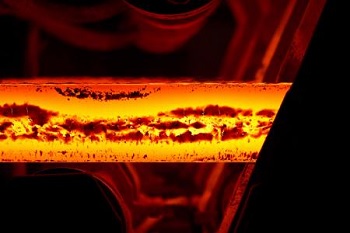Feb 16 2015
Researchers at Caltech’s Division of Engineering and Applied Science have discovered that the magnetism of iron plays a role in how the material is able to take on various forms.

When iron is heated for melting, its atomic arrangement undergoes changes many times before it finally melts. Steel is very strong and widely used.
Iron plays an important role in steel and its unusual property of change in atomic arrangement provides the sturdiness demonstrated by steel.
This discovery may help develop stronger and better steel. However until now, the reason for why and how iron takes on multiple forms has been a mystery.
Humans have been working with regular old iron for thousands of years, but this is a piece about its thermodynamics that no one has ever really understood.
Brent Fultz, the Barbara and Stanley R. Rawn, Jr., Professor of Materials Science and Applied Physics
A material’s natural behavior, which includes the chemical reaction timings and the water boiling temperature, are governed by the laws of thermodynamics. The arrangement of atoms in solids is also determined by the same principles. In iron, at high temperatures, its nature changes multiple times.
However, at room temperature, the atoms of iron have a strange loosely packed open arrangement. When iron is heated to melt, its atomic arrangement becomes closely packed when the temperature exceeds 912°C. At temperature of 1,394°C the atoms loosen again and the material melts at 1,538°C.
At room temperature, iron is magnetic; however at 770°C it loses its magnetism. Previous studies have suggested that the magnetic property of iron prefers open structure at low temperatures.
However, even for more than a hundred degrees exceeding 770°C, the open structure is maintained by iron. Hence, the researchers suspected that an unknown factor was responsible for the unusual thermodynamic properties demonstrated by iron.
Lisa Mauger, a graduate student, and her colleagues turned to heat to find out the reason. Heat is stored by solids in the form of small atomic vibrations. These vibrations create entropy or disorder. Entropy dominates thermodynamics at high temperatures, and in iron the largest source of entropy are atomic vibrations.
The research team aimed to find out the driving force behind the atomic structural rearrangements by studying the change in vibrations when the temperature increases and iron loses its magnetism.
The researchers took their iron samples to Argonne National Laboratory in Argonne, Illinois. At the Advanced Photon Source of this lab, studies were conducted at the High Pressure Collaborative Access Team beamline. Intense x-ray flashes can be produced at this synchrotron facility and they can be tuned to detect phonon excitations in iron, which are the quantum particles of atomic vibration.
The team combined the observed vibrational measurements and earlier data known about iron’s magnetic behavior at such high temperatures. The vibrational entropy of iron was found to be a great deal larger than what it was suspected to have.
The magnetism’s entropy contribution and this excess were found to be similar. This suggests that at moderate temperatures, atomic vibrations and magnetism interact synergistically. The iron's open structure stability is increased by this excess entropy, even when the iron sample was heated beyond the magnetic transition.
Based on this technique, the team was able to experimentally conclude that iron's stability at high temperatures was increased by the interaction of magnons and phonons. The quantum particles of electron spin are known as magnons.
At Jörg Neugebauer’s laboratory at the Max-Planck-Institut für Eisenforschung GmbH (MPIE), collaborators had been simultaneously developing theoretical calculations. These calculations matched with the measurements obtained by the Caltech group, and they helped validate a new computational model.
"It has long been speculated that the structural stability of iron is strongly related to an inherent coupling between magnetism and atomic motion," says Fritz Körmann, postdoctoral fellow at MPIE and the first author on the computational paper. "Actually finding this coupling, and that the data of our experimental colleagues and our own computational results are in such an excellent agreement, was indeed an exciting moment."
"Only by combining methods and expertise from various scientific fields such as quantum mechanics, statistical mechanics, and thermodynamics, and by using incredibly powerful supercomputers, it became possible to describe the complex dynamic phenomena taking place inside one of the technologically most used structural materials," says Neugebauer. "The newly gained insight of how thermodynamic stability is realized in iron will help to make the design of new steels more systematic."
Metallurgists have been endeavoring to develop stronger steels using a guess and check method for thousands of years. This is similar to the method used for developing a recipe to make a good cookie.
Iron and carbon are the standard ingredients in steel in the same way as flour and butter are to making a cookie. Similar to the way in which a cookie recipe can be customized by adding spices, nuts and other ingredients, steel’s properties can be tuned by adding chromium, nickel and other elements in various quantities.
The new computational model derived for thermodynamics of iron at various temperatures will help metallurgists to predict the iron alloy’s thermodynamic properties more accurately when they keep changing the other component elements of the alloys. This new computational model considers the effects of both atomic vibrations and magnetism.
This study has been published in the journal Physical Review B as a paper titled "Nonharmonic Phonons in α-Iron at High Temperatures." Jorge Alberto Muñoz (PhD '13) and Sally June Tracy, graduate student, were the other coauthors of the study.
Researchers at the Max Planck Institute led the study titled, "Temperature Dependent Magnon-Phonon Coupling in bcc Fe from Theory and Experiment," which was coauthored by Mauger and Fultz. This was published in Physical Review Letters journal. The U.S. Department of Energy has provided funds for Fultz's and Mauger's study.